|
"Insects play a
surprisingly large role, given their size, in non-Western art and
mythology. Indigenous peoples acutely observed the life around them,
witnessing insects' appearance, behavior, and life cycles and
incorporating them into their symbolism."--------2006,
Hope B. Werness, "The Continuum, Encyclopedia Of Animal Symbolism
In Art" pp. 237-238.
"The locust
image appearing in many of the (poverty Point
culture) effigy beads may have been
inspired by the insect's unique characteristics."------2004,
Susan C. Power, "Early Art Of The Southeast Indians, Feathered
Serpents & Winged Beings,"
p. 18.
"Even the
locust (or thirteen year cicada) had traditional importance. The
Choctaws tied the cicada to the birth of humans,---."--------2001,
Jon L. Gibson, "The Ancient Mounds Of Poverty Point," p. 191.
"Scarab
(is) an
image or representation of a dung beetle which was very common in
ancient Egypt, especially on the Egyptian stamp seal."----2007,
Barbara Ann Kipfer, " Dictionary Of Artifacts," p. 181.
"One of the most spectacular discoveries in the
Great Deposit at Hierakonpolis was a large white limestone ceremonial
macehead belonging to the Protodynastic king Scorpion, the probable
predecessor of Narmer"---------1984,
Michael A. Hoffman, "Egypt Before The Pharaohs, The Prehistoric
Foundations Of Egyptian Civilization," p. 313.
"An appealing
seasonal image (at the cave site of Les Trois
Freres in southwestern France) is of
an Ice Age grasshopper in a composition of birds and what looks like
pupae or insect eggs"---------1991,
Alexander Marshack, "The Roots Of Civilization" p. 184.
"In later
Stone Age times, a remarkable illustration of the interest of early man
in insects, or more strictly in this case in their products, is the
honey-hunting scene depicted in a cave at Arana, Spain. Further evidence
is to be seen on a bone fragment from the Magdalenian site of Les Trois
Freres, in southern France, which depicts a grasshopper."--------1969,
Don R. Brothwell, "Food In Antiquity: A Survey Of The Diet Of Early
Peoples," p. 69.
"Only about a
dozen definite or probable depictions of insects are known (within
the Ice Age Period), all in portable
art, and mostly Magdalenian (17,000-12,000
year span)."--------1997,
Paul G. Bahn & Jean Vertut, "Journey Through The Ice Age," p. 156.

INSECT ICONOGRAPHY
WORLDWIDE
est. 15,000 YEARS AGO TO PRESENT DAY
The use of insect imagery among Stone Age
cultures around the world is quite extraordinary. They have been carved,
painted, engraved, flaked and sculpted into many different varieties of
natural and stylized forms. Insects are the most common type of animal
life. So it's not surprising they are represented in so many different
mythic stories. They vary in importance from things-most-common to great
and powerful gods. |
|
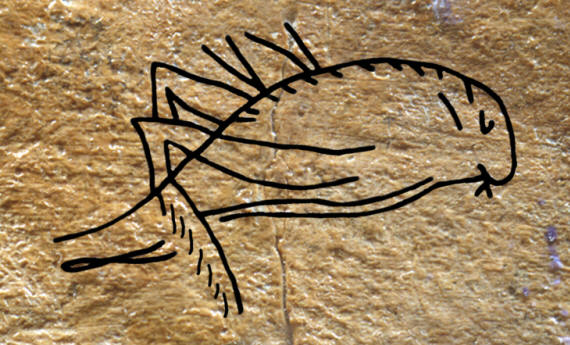
COMPUTER GENERATED, DRAWING,
ON MAMMOTH BONE BACKGROUND.
COMPUTER RENDITION OF
GRASSHOPPER ENGRAVED ON BONE
TROIS FRERES CAVE SITE,
SOUTHWESTERN FRANCE
MAGDALENIAN PERIOD
This picture was computer generated
to show an Ice Age example of insect imagery. The image represents a
grasshopper engraved on bone that was found on the Magdalenian site
of Trois Freres Cave in southwestern France. It's believed to date
to about 15,000 years ago. Bahn reports that approximately twelve
insect or insect-like images have been found on pieces of portable
objects that date to the Magdalenian Period. Any intended
mythological meaning is lost in time. But since insects are a source
of food the engravings may relate more importantly to food. Just as
the image of a bee would relate to honey as the probable food
source. |
|
|
The earliest examples of insect imagery begin to appear
during the Magdalenian Period in the south of France. Bahn reports that
approximately twelve insect or insect-like images have been found on
pieces of portable objects that date to the Magdalenian Period. One
example is a grasshopper engraved on bone that was found on the
Magdalenian site of Trois Freres Cave in southwestern France. It's believed to date
to about 15,000 years ago. Any intended natural or mythological meaning is lost
in time. But since insects are a source of food the engravings may
relate more importantly to food, just as the image of a bee would relate
to honey. |
|
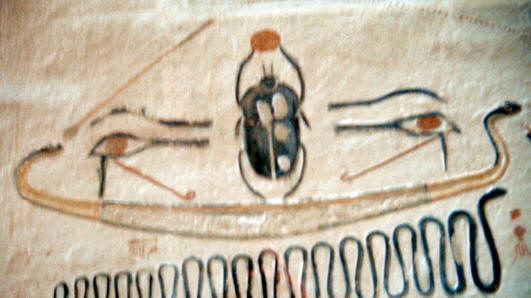
PHOTO CREDIT LITHIC CASTING
LAB'S COLLECTION OF ORIGINAL IMAGES.
SCARAB HIEROGLYPH ON TOMB WALL
VALLEY OF THE KINGS, TOMB KV6
EGYPT
Of all the ancient insect
images that's been depicted on mammoth bones or tomb walls, the Egyptian
scarab beetle was the most extravagantly ritualized, in ceremony and
image production. This
seemingly insignificant animal life form was actually revered as the
personification of the god Khepri. Khepri was considered the morning
aspect of the sun god that represented the origin of life, rebirth, and
the eternal life force. The idea appears sometime during the Predynastic
Period approximately 5,000 years ago. The scarab image relates to the
dung beetle. The engraved and painted image of a scarab can be seen in
the above picture of a tomb wall located in the Valley of the Kings. It
shows the beetle pushing a ball of dung that represents the sun's
passage across the sky. The definition of the word scarab beetle and the
word existence was the same, meaning "to come to be" or "to happen." The
scarab beetle was also referred to as Kheper. |
|
|
The oldest insect images found in the U.S. have
been found on stone beads on Poverty Point sites. The Poverty Point
culture represents the people who were living in and around the states
of Louisiana, Mississippi and Arkansas between 4,200 and 2,700 years
ago. A few examples of their beads have been found that portray stylized
versions of cicadas or locusts. The meaning behind the locust image may
relate to a natural ability, such as jumping, loud singing, or its
destructive power of devouring large amounts of vegetation. Estimated
dates for Poverty Point beads range between 3,350 to 3,730 years ago.
Morse writes that, "---the "lapidary industry" is most characteristic of
the Poverty Point period in the (Mississippi)
valley." They were producing plain tubular beads but their animal effigy
beads are the most impressive. Birds were a common theme but they were
also making beads in the form of bears, squirrels, rabbits, dogs, and
frogs. |
|
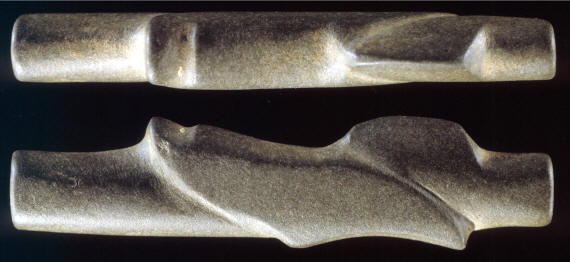
CLICK ON PICTURE FOR MORE EFFIGY BEADS
STONE CARVED CICADA BEAD
POVERTY POINT CULTURE
ALABAMA
This stone bead is believed
to represent a stylized version of a cicada or locust. Its main feature
is the upswept wings that extend beyond the body. It was made by a
Poverty Point craftsmen sometime between 3,350 and 3,730 years ago. The
Poverty Point culture represents the people who were living in an area
in and around the states of Louisiana, Mississippi and Arkansas at that
time. The Poverty Point site is located in northeastern Louisiana, where
the largest earthworks of the period were built. Some of the nicest
examples of carved and polished stone beads have been found in this
area. Morse writes that, "---the "lapidary industry" is most
characteristic of the Poverty Point period in the (Mississippi)
valley." They were producing plain tubular beads but their animal effigy
beads are the most impressive. Birds were a common theme but they were
also making beads in the form of bears, squirrels, rabbits, dogs, and
frogs.
Poverty Point beads can be highly stylized in their form.
Power writes that, "These artists did not strive for photographic
realism. Later Native Americans explain this type of visual
representation as symbolizing all owls or locusts, as the mind knows
them to be, rather than merely depicting an individual bird or insect."
The meaning behind the locust image may relate to a natural ability,
such as jumping, loud singing, or its destructive power of devouring
large amounts of vegetation. |
|
|
Another insect image that appears more recently in the
U.S. is the spider. The two examples illustrated in this report were
found on the Crable site in Fulton County, Illinois and date to the Mississippian
Period sometime between A.D. 1400 and 1450. Images of spiders in North
America have a strong connection to women and weaving in the form of a
mythical being called Spider Woman. Spider images begin to appear more
often in the U.S. on items made by late Stone Age cultures in the
eastern half of the country. But the spider motif (design or pattern)
with its various meanings appear as far north as the Tlingit of North
America's Northwest Coast and as far south as Indian cultures in South
America. The spider myths do seem to coalesce in some way, as Franke
writes, "When one looks at the legends that relate to Spider Woman from
the Americas as a whole, one sees that although beliefs differ from
tribe to tribe, a relatively coherent image of Spider Woman emerges. She
is generally a premier goddess of earth and sky, a creator being and a
consort of the sun." But as the mythological interpretations are viewed
around the world, spiders can be seen as having either positive or negative
energy. As negative symbols they are associated with divination,
illusion, and ensnarement. As positive symbols they are related to good
luck, wealth, protection from storms and emblems of bringing heavenly
gifts. |
|
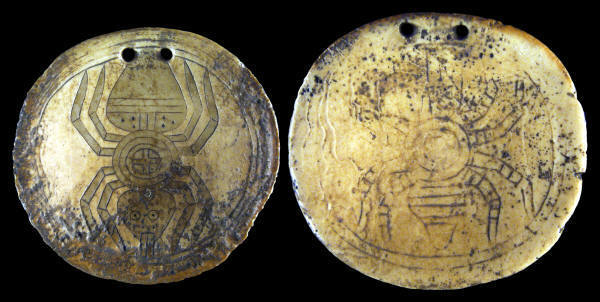
PHOTO OF CASTS OF GORGETS
FROM THE LAKEVIEW MUSEUM OF ARTS & SCIENCES COLLECTION
CLICK ON PICTURE FOR LARGER IMAGE
SPIDER SHELL GORGETS
CRABLE SITE
FULTON COUNTY, ILLINOIS
Spider images have been
around for a long time. They have been connected to powerful myths
around the world for thousands of years. The earliest spiders, along
with their webs, are painted on the walls of open rock
shelters in Spain that date to the Paleolithic Period, at least 10,000
years ago. Spider images also appear as recently as the two examples in
this picture. Both of these shell gorgets have large spiders engraved
across the surface of one side. The example on the left has been
computer enhanced to show the outline of the spider. They were found on
the Crable site in Fulton County, Illinois and date to the Mississippian
Period sometime between A.D. 1400 and 1450.
Images of spiders in North America have a strong connection to
women and weaving in the form of a mythical being called Spider Woman.
Spider images begin to appear more often in the U.S. on items made by
late Stone Age cultures in the eastern half of the country. But the
spider motif (design or pattern)
with its various meanings appear as far north as the Tlingit of North
America's Northwest Coast and as far south as Indian cultures in South
America. The spider myths do seem to coalesce in some way, as Franke
writes, "When one looks at the legends that relate to Spider Woman from
the Americas as a whole, one sees that although beliefs differ from
tribe to tribe, a relatively coherent image of Spider Woman emerges. She
is generally a premier goddess of earth and sky, a creator being and a
consort of the sun." But as the mythological interpretations are viewed
around the world, spiders can be seen as having either positive or negative
energy. As negative symbols they are associated with divination,
illusion, and ensnarement. As positive symbols they are related to good
luck, wealth, protection from storms and emblems of bringing heavenly
gifts. |
|
|
The insect that was revered more than any other was the
lowly dung beetle. Of all the ancient insect images that's been depicted
on mammoth bones or tomb walls, the Egyptian scarab beetle was the most
extravagantly ritualized, in ceremony and image production. This
seemingly insignificant animal life form was actually revered as the
personification of the god Khepri. Khepri was considered the morning
aspect of the sun god that represented the origin of life, rebirth, and
the eternal life force. The idea appears sometime during the Predynastic
Period approximately 5,000 years ago. The scarab image relates to the
dung beetle. The engraved and painted image of scarabs can be seen on
tomb walls in the Valley of the Kings. The images portray the beetle
pushing a ball of dung that represents the sun's passage across the sky.
The definition of the word scarab beetle and the word existence was the
same, meaning "to come to be" or "to happen." The scarab beetle was also
referred to as Kheper. |
|
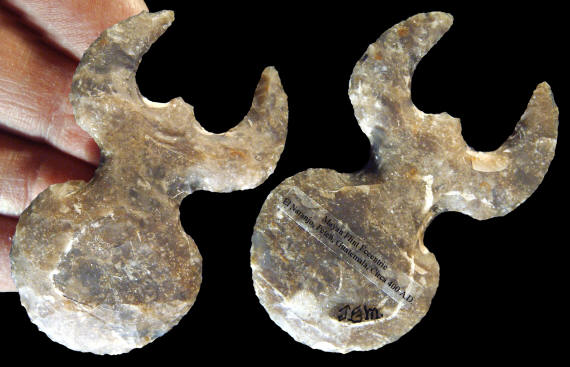
CLICK ON PICTURE FOR LARGER IMAGE
SPIDER ECCENTRIC
MAYA CULTURE
NARANJO, GUATEMALA
This Mayan
eccentric was flaked into the shape of a spider. The image has a large
abdomen, a narrow thorax in the center, two legs and what seems to be
small jaws at the front. Although it's a stylized version of a spider,
the large round abdomen and forward directional legs are the main
features that provides the observer with an easy identification. |
|
|
The Maya culture produced the only insect images that
were flaked from stone. They are identified within a group of artifact
types known as eccentric flints. Mayan insect eccentrics were flaked
into both natural and highly stylized shapes of spiders, scorpions, and
centipedes. Although the natural images are fairly natural in form, much
of the insect's design may be missing. But enough of the insect is
represented to be easily identified. A spider may be represented with a
large abdomen, a narrow thorax, two legs and small jaws at the front.
Although it's a stylized version of a spider, the large round abdomen
and forward directional legs are the features that provide the observer
with an easy identification. A scorpion may have a large curving tail,
several legs, and two representations of claws at the front. The large
curving tail, the forward directional claws and two rows of legs are
more than enough to identify it as a scorpion. A centipede will have
rows of projections along two sides and forward and rearward projections
on the ends. The multiple legs are its most identifying trait. |
|
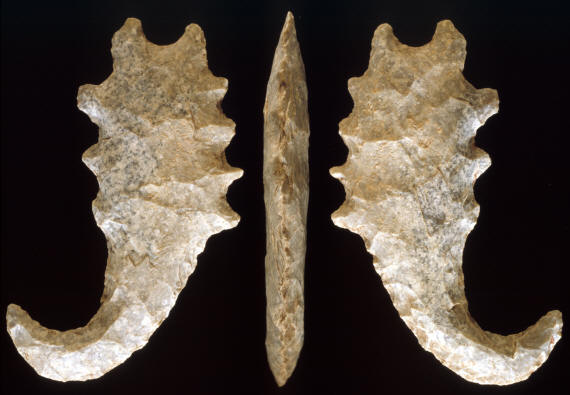
CLICK ON PICTURE FOR LARGER IMAGE
SCORPION ECCENTRIC
MAYA CULTURE
GUATEMALA
This Mayan eccentric was flaked into the shape of a scorpion.
Although there are more stylized versions, this example has a fairly
natural form. It has a large curving tail, seven legs instead of
eight, and two representations of claws at the front. The large
curving tail and the forward directional claws in front of two rows
of legs are the main features that provides the observer with an
easy identification. |
|
|
One of the oddest insect images is the mosquito.
Mosquitoes are rarely represented in art but there are at least two
areas in the world where people have carved wooden masks to represent
mosquitoes. Their most distinguishing feature is the long beak-like
extension that represents a proboscis. The Tlingit people of the Pacific
northwest made mosquito masks that were worn in ceremonies. Their
purpose is described as portraying comic characters to bring a smile.
Another area in the world where mosquito masks have been used is along
the Sepik River in Papua, New Guinea. One of the tribes there is the Swagap
tribe which is also known as the insect tribe. |
|
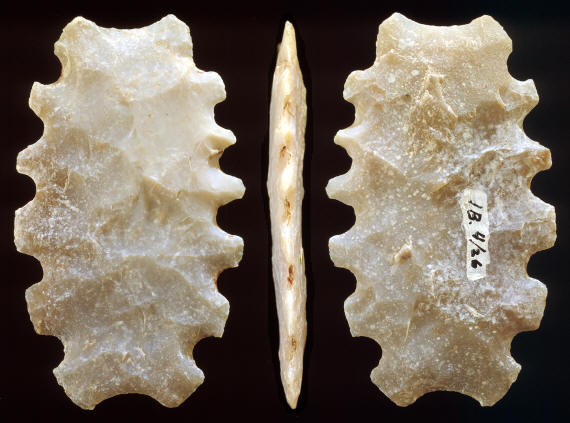
CLICK ON PICTURE FOR LARGER IMAGE
CENTIPEDE ECCENTRIC
MAYA CULTURE
GUATEMALA
This Mayan eccentric is believed to represent a stylized version of
a centipede. The single and most obvious feature are the rows of
projections along each side. Plus the forward and rearward
projections caused buy the concave design of the ends. The multiple
legs and the forward directional point that suggest antenna are the
main features that indicates this Mayan eccentric may represent a
centipede. |
|
|
The butterfly may be the world's most symbolized
insect, mainly because of its beautiful colors and delicate flight.
Trudge writes that, "--they are truly among the glories of nature."
Butterflies are often
used to represent the human soul and immortality. In other
interpretations they are seen as the generative force of nature,
fertility, symbols of beauty that contrast with the dangerous,
longevity, love, transient joy, womanhood, female vanity, and Japanese
geisha. In Mexico, at the ancient site of Teotihuacan, butterflies are
linked with fire and war. On the column ruins at Tula, northwest of
Mexico City, the Toltec warriors wear butterflies on their breastplates. |
|
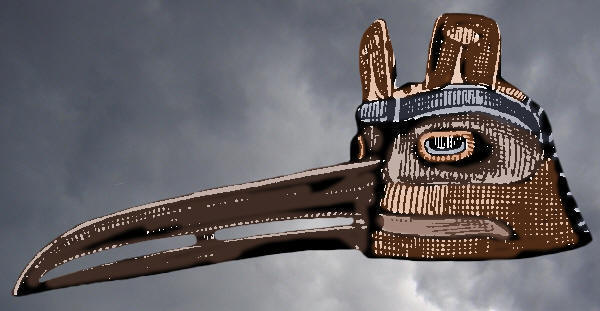
COMPUTER ALTERED IMAGE FROM
1895 ANNUAL REPORT
OF THE BOARD OF REGENTS OF THE SMITHSONIAN INSTITUTION
MOSQUITO-LIKE WOOD MASK
NORTHWEST COAST
Mosquitoes are rarely
represented in art but there are at least two areas in the world where
people have carved wooden masks to represent mosquitoes. Their most
distinguishing feature is the long beak-like extension that represents a
proboscis, like the example illustrated here, which may-or-may-not
represent a mosquito. The Tlingit people of the Pacific northwest made
mosquito masks that were worn in ceremonies. Their purpose is described
as portraying comic characters to bring a smile.
Another area in the world where mosquito masks have been used is
along the Sepik River in Papua, New Guinea. The people belong to the
Swagap tribe which is also known as the insect tribe. |
|
|
Although insect
iconography would seem to have a limited history, volumes of books could
be written on the subject. Insects have been described in mythic tales
with having just about every type of human ability and power, from comic
actors to the human soul. Who would ever have imaged that a dung beetle
could represent the origin of life, rebirth, and the eternal life force.
The lowly insect. |
|
"REFERENCES"
1895, Boas, Franz, "The Social
Organization And The Secret Societies Of The Kwakiutl Indians,"
Annual Report Of The Board Of Regents Of The Smithsonian Institution.
1969, Brothwell, Don R., "Food In Antiquity: A Survey Of The Diet Of
Early Peoples,"
1983, Morse, Dan F. & Morse, Phyllis A., "Archaeology Of The Central
Mississippi Valley."
1984, Hoffman, Michael A., "Egypt Before The Pharaohs, The
Prehistoric Foundations Of Egyptian Civilization,"
1988, Tattersall, Ian, Delson, Eric & Couvering, John Van,
"Encyclopedia Of Human Evolution And Prehistory."
1991, Marshack, Alexander, "The Roots Of Civilization"
1997, Paul G. Bahn & Jean Vertut, "Journey Through The Ice Age,"
1998, Gibson, Jon L., "The Ancient Mounds Of Poverty Point."
1999, Franke, Judith A., "The Gift Of The Spider Woman," The
Living Museum, Vol. 61, No. 2.
2000, Trudge, Colin, "The Variety Of Life, A Survey And A
Celebration Of All The Creatures That Have Ever Lived."
2001, Gibson, Jon L., "The Ancient Mounds Of Poverty Point,"
2004, Power, Susan C., "Early Art Of The Southeast Indians,
Feathered Serpents & Winged Beings,"
2004,Tresidder, Jack, "The Complete Dictionary Of Symbols."
2006, Werness, Hope B., "The Continuum, Encyclopedia Of Animal
Symbolism In Art"
2007, Kipfer, Barbara Ann, " Dictionary Of Artifacts,"
|
|
RECENT
LISTINGS HOME
ORDERING |